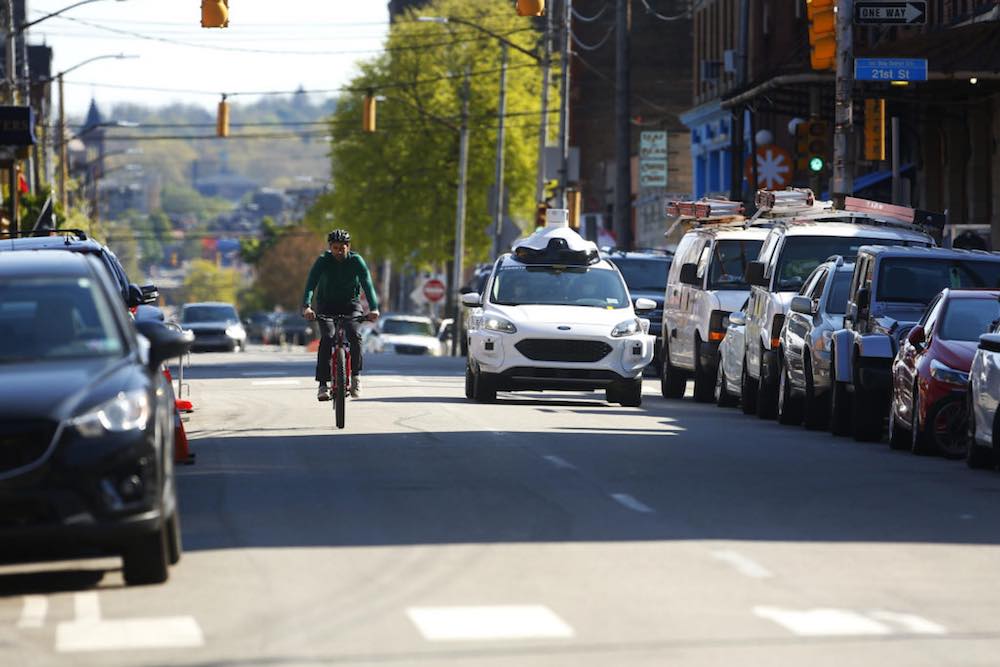|
Listen to this article  |

Cyclists present unique challenges for autonomous vehicles. | Photo Credit: Argo AI
Bicyclists can present unique challenges for human drivers. Their behavior can be hard to predict, and they can change lanes or swerve to avoid obstacles faster than other drivers. In 2020, fatal accidents involving bicyclists rose 5% (846) over 2019, according to NHTSA.
Autonomous vehicles face those same challenges, which is why companies making self-driving systems need to take extra care when considering bicyclists. While autonomous cars have the potential to reduce vehicle accidents and make roads safer, they first need to learn the best way to navigate the road.
Argo AI, a company working on its own self-driving system, in collaboration with The League of American Bicyclists, released its own best practices for creating self-driving systems that operate safely around bicyclists.
“Argo AI and the League of American Bicyclists share a common goal to improve the safety of streets for all road users,” said Ken McLeod, policy director, the League of American Bicyclists. “We appreciate Argo’s proactive approach to researching, developing, and testing for the safety of people outside of vehicles. Roads have gotten significantly less safe for people outside of vehicles in the last decade, and by addressing interactions with bicyclists now, Argo is demonstrating a commitment to the role of automated technology in reversing that deadly trend.”
Here are the suggested six guidelines to follow when developing autonomous driving systems.
1. Cyclists should be a unique object class
For a self-driving car to be able to react to a cyclist on the road, it first needs to understand what cyclists are and how they move. Cyclists don’t behave like anything else on the road, so it’s important that a self-driving system designates them as a core object representation within its perception system.
By labeling a diverse set of bicycle images, a self-driving system can recognize a cyclist from any viewpoint, speed and bicycle position or orientation. Self-driving systems should also be able to recognize different shapes and sizes of bicycles, such as recumbent bikes or electric bikes.
2. Typical cyclist behavior should be expected
There are certain behaviors that are common for bicyclists that self-driving systems should be able to recognize and anticipate. Lane splitting, yielding at stop signs or walking a bicycle are all behaviors that self-driving systems need to be able to recognize and react appropriately to.
Self-driving systems should use specialized cyclist-specific forecasting models. With these models, when a car encounters a bicyclist, it can predict many potential path’s for the cyclist, making it easier for the car to predict and respond to the cyclist’s actions.
This 2019 video shows how a Waymo autonomous vehicle approaches two cyclists and a vehicle blocking a bike lane. The self-driving system correctly predicts the cyclists will pass the vehicle on the left and slows down to allow them to pass.
3. Cycling infrastructure and local laws should be mapped
Many cities and states have specific laws for cyclists that a self-driving car should be aware of. For example, in some states cyclists are allowed to treat red lights as stop signs. Additionally, mapping for self-driving cars should include any bike lanes. Knowing where bike lanes are will allow a self-driving car to anticipate more bikers in those areas, and keep extra watch for common cyclist behaviors.
4. Drive in a consistent and understandable way
The goal of self-driving cars is to replicate, and improve upon, human driving. This means that self-driving cars should communicate with cyclists and other drivers on the road the same way a human driver would. Self-driving cars should use turn signals wherever appropriate to help others understand its intentions.
Self-driving cars should also maintain a greater following distance with cyclists the way that a human driver would. They should also take extra care when passing cyclists.
5. Prepare for uncertain situations and proactively slow down
It’s inevitable that, sometimes, drivers and cyclists act unpredictably and self-driving cars aren’t sure how to react. When this happens, the car should slow down and create more distance between the car and cyclist, if possible. Self-driving systems should always account for uncertainty.
6. Cyclist scenarios should be tested continuously
Thorough testing is one of the most important things when developing a self-driving system. Testing in both simulation and the real world is crucial to making a system that can operate safely around bicyclists.
Simulation should be used to test real-life scenarios in a virtual world to safely test different scenarios. These scenarios should capture vehicle and cyclist behavior, as well as changes in road structures and visibility. Real-world testing should be used to validate simulations and ensure the technology behaves the same as it did in a simulation.
Credit: Source link


Comments are closed.